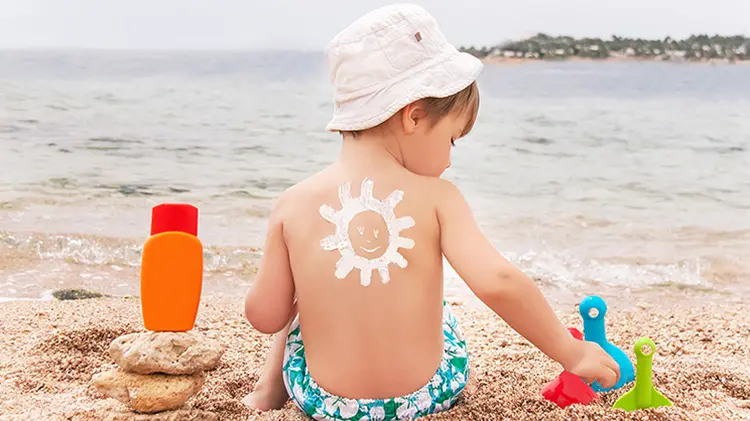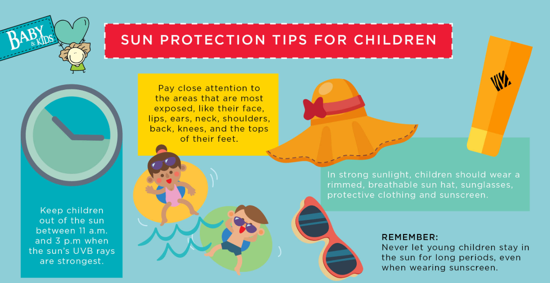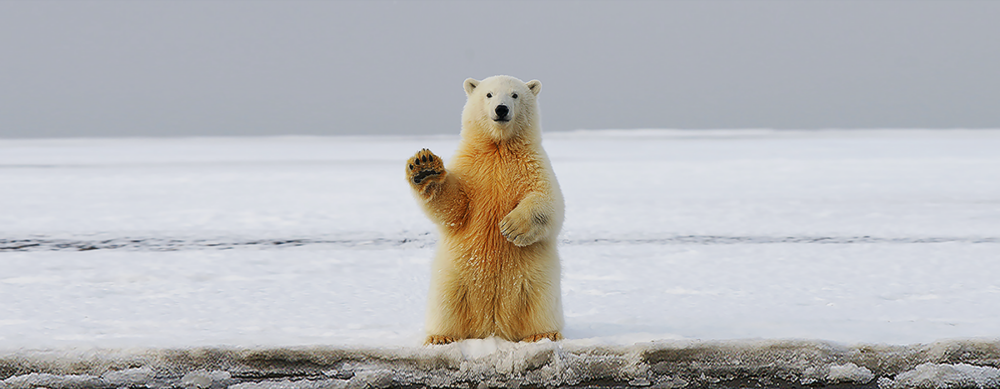Protecting children from the harmful effects of the sun is of paramount importance. Excessive sun exposure during childhood can lead to short-term issues like sunburn and long-term consequences such as an increased risk of skin cancer.
This article aims to provide a comprehensive guide on sun protection for children, offering practical tips and strategies for safeguarding their delicate skin from the sun’s harmful rays
Understanding the Risks
It is crucial to understand the risks associated with sun exposure to emphasize the importance of sun protection for children.
1.1. Sunburn:
Children’s delicate skin is more vulnerable to sunburn due to its reduced ability to produce melanin, the pigment that provides some natural protection against the sun’s UV rays. Sunburn can cause pain, redness, blistering, and in severe cases, dehydration and fever.
1.2. Long-term Effects:
Cumulative sun exposure throughout childhood significantly increases the risk of skin cancer later in life. Melanoma, the most deadly form of skin cancer, has been linked to sunburns and excessive UV exposure during childhood.
Sun Protection Measures
To safeguard children from the sun, a combination of preventive measures should be implemented.
2.1. Seek Shade:
Encourage children to seek shade, especially during the peak hours of sun intensity, typically between 10 a.m. and 4 p.m. Shade provides natural protection from direct UV rays and reduces the risk of sunburn.
2.2. Protective Clothing:
Dressing children in protective clothing is an effective way to shield their skin from the sun. Consider the following clothing tips:
- Choose lightweight, loose-fitting, and tightly woven fabrics that cover as much skin as possible.
- Opt for long-sleeved shirts, long pants, and wide-brimmed hats to provide shade to the face, neck, and ears.
- Look for clothing with UPF (Ultraviolet Protection Factor) labels, indicating the level of sun protection provided by the fabric.
2.3. Sunscreen Application:
Proper and regular sunscreen application is crucial for protecting children’s exposed skin. Follow these guidelines:
- Use a broad-spectrum sunscreen with an SPF (Sun Protection Factor) of 30 or higher.
- Apply sunscreen generously to all exposed skin, including the face, ears, neck, arms, and legs.
- Reapply sunscreen every two hours or more frequently if children are sweating or swimming.
- Choose a sunscreen specifically formulated for children to minimize the risk of skin irritation.

2.4. Sunglasses:
Protecting children’s eyes from harmful UV rays is equally important. Look for sunglasses that:
- Provide 100% UV protection.
- Fit well and have impact-resistant lenses to reduce the risk of breakage.
- Are labeled as suitable for children to ensure proper fit and comfort.

Education and Awareness for sun protection
Educating children about sun protection from an early age promotes lifelong healthy habits. Teach them the following:
- The importance of seeking shade and wearing protective clothing.
- How to apply sunscreen properly, covering all exposed areas.
- The significance of wearing sunglasses to protect their eyes from UV damage.
- The dangers of excessive sun exposure and the long-term risks of skin cancer.
- Role Modeling and Supervision:
Adults play a vital role in modeling and enforcing sun protection habits for children. Set a good example by following sun protection measures yourself and encourage children to adopt the same practices. Provide supervision, particularly for younger children, to ensure they are adequately protected. - Special Considerations:
Certain situations require additional attention and precautionary measures:
5.1. Infants:
Infants under six months of age have highly sensitive skin and should be kept out of direct sunlight as much as possible. When limited sun exposure is unavoidable, dress them in lightweight, protective clothing, use stroller shades or umbrellas, and consult a pediatrician regarding the use of sunscreen.
5.2. Medications and Sensitivities:
Some medications can increase sensitivity to the sun. Consult a healthcare professional or pharmacist to determine if any medications your child is taking may require extra sun protection measures. Additionally, children with skin conditions or sensitivities may require specialized sunscreens or alternative sun protection methods. Seek advice from a dermatologist if needed.
Encouraging Healthy Sun Habits for sun protection
Promote a positive attitude towards sun protection by:
- Incorporating sun protection habits into daily routines.
- Encouraging outdoor activities during non-peak sun hours.
- Providing comfortable and protective sun-protective clothing options.
- Engaging children in fun activities that reinforce sun protection messages, such as applying sunscreen on toys or role-playing sun safety scenarios.

Protecting children from the sun’s harmful rays is crucial to prevent sunburn, reduce the risk of skin cancer, and promote long-term skin health. By implementing a combination of sun protection measures, educating children, and modeling healthy habits, parents and caregivers can ensure that children enjoy outdoor activities while minimizing the risks associated with sun exposure. Remember, the earlier sun protection habits are instilled, the better equipped children will be to make informed choices about sun safety as they grow older.
(Disclaimer: The information given here is based on general information. Before adopting it, definitely take medical advice. THE MONK does not endorse it.)


























